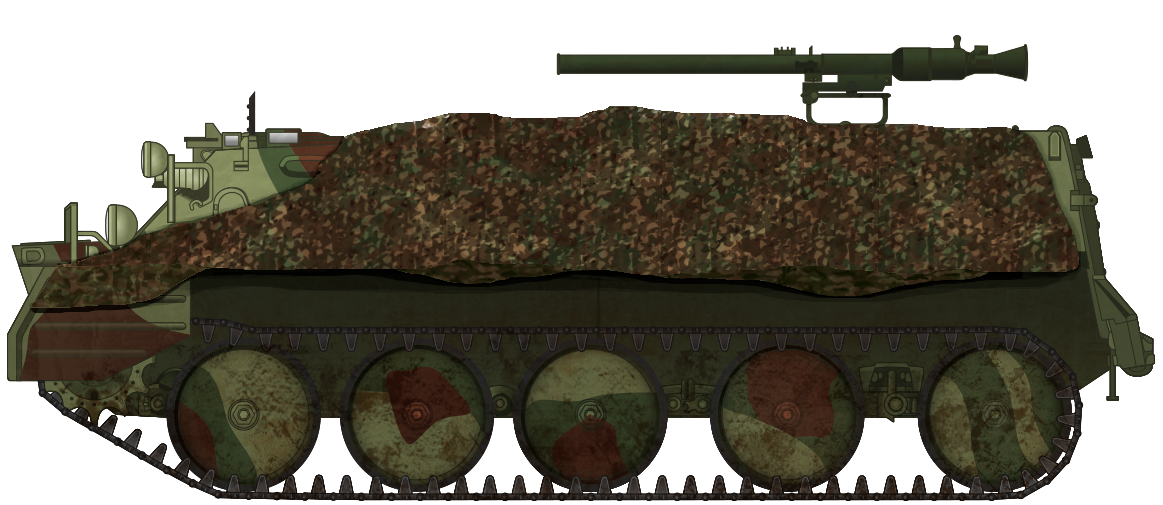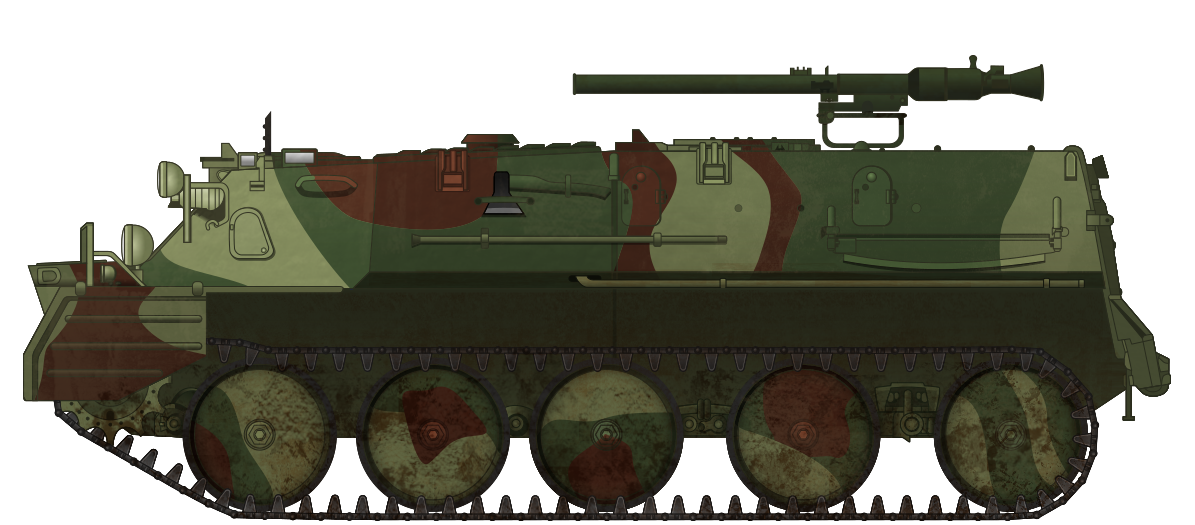 Pridnestrovian Moldavian Republic (2018 At The Latest-Present)
Pridnestrovian Moldavian Republic (2018 At The Latest-Present)
Fire Support Vehicle – At Least 3 Converted
The Pridnestrovian Moldavian Republic, better known as Transnistria, is a breakaway state located in the internationally-recognized territories of the Republic of Moldova, on the Eastern side of the Dniester River, along the border with Ukraine. It seceded from Moldova during the dissolution of the Soviet Union, due to its ethnic makeup including a large number of Ukrainians and Russians who did not want to be part of the Moldovan state. The unrecognized state’s army has relied on leftover Soviet equipment from the former 14th Guards Army, which was based at Transnistria’s capital of Tiraspol, to equip its formations. This army’s location near an important river led to it having a large quantity of various engineering vehicles, which Transnistria has had to find use for and re-purpose for the defence of its territories. An example of these is the GT-MU, of which some examples have been converted to serve as fire-support vehicles.
The GT-MU Multi-Purpose Vehicle
The GT-MU (GT-MU being the Soviet Army designation; it is referred to as GAZ-73 by the manufacturer, Gorky Automobile Plant) is a small tracked vehicle which entered production in the Soviet Union in 1971. The vehicle is based on the previous GT-SM or GAZ-71, a fully tracked but unarmored tractor/prime mover with six road wheels. The GT-SM itself was based on the previous GT-S or GAZ-47, a vehicle of similar purpose from the mid-1950s.

In comparison to the GT-SM, the GT-MU was shortened to have six road wheels, but adopted a fully armored body with an all-round thickness of 6 mm. The vehicle is best described as a small and light multi-purpose ‘mule’, with a loaded weight of 5.8 tonnes on average, a length of 5.15 m, a width of 2.47 m and a height of 1.70 m. The movement of its tracks provides amphibious capabilities, and is powered by a V8 115 hp liquid-cooled engine, giving it a fairly high power-to-weight ratio of 26.24 hp/ton. The vehicle uses a torsion bar suspension with a front sprocket. There is no rear idler wheel, with the road wheel furthest to the back playing the role of keeping the track tensioned. The vehicle is able to reach about 55 km/h on roads and 5.5 km/h in the water.
In the Soviet Army, the GT-MU could be used as an armored personnel carrier. In addition to a crew of two, a driver and a commander, it could carry eight infantry dismounts in a rear compartment. However, with no armament to speak of (firing ports were present in the infantry dismount compartment though) and little armor protection, the vehicle was far less optimal than the various BTRs for this role, and this was not its main intended usage. The GT-MU was to serve as a prime mover which could, for example, tow 85 mm D-44 or 100 mm MT-12 anti-tank guns, or mortars. The vehicle could also be employed for a large variety of specialist uses, including by border guard units, and as an electronic warfare vehicle with radar jamming devices or a surveying vehicle, with the large rear compartment being used to house specialist equipment. Overall, the vehicle served as a formidable multi-purpose ‘mule’, not too different from the pre-war T-20 Komsolets or the post-war AT-P in a general role, though adapted for a much more technological and communications-based conflict.
The GT-MU in the Transnistrian Army
The GT-MU was in service in considerable numbers with the 14th Guards Army, with its headquarters in Tiraspol, Transnistria. Considering its location around the Dniester, the use of various engineering and multi-purpose vehicles was not lost on this particular Army.
During the breakdown of the Soviet Union, Transnistria affirmed its independence from Moldova due to conflicts over the prevalence of the Moldovan language and ethnicity. Though officially not involved, the 14th Guards Army often opened its warehouses to Transnistrian forces, gifted them equipment, or trained them. From this source, Transnistria is thought to have obtained a fleet of one or two dozen GT-MUs, though exact numbers are unknown. The vehicles are not known to have been used during the 1990-1992 war with Moldova.

The GT-MU was pressed into service with the Transnistrian Army to fulfil many tasks which were fairly similar to what was expected of them in the Soviet Army. The vehicle has still been regularly used as a prime mover for artillery pieces and mortars. However, the use of advanced jamming or surveying vehicles is rather lost on a Transnistrian military which struggles to obtain enough basic combat vehicles to outfit its formations. For these reasons, GT-MUs were quickly repurposed for other roles for which their small size, decent internal space, and good mobility could prove favorable. The vehicles have, for example, been used as artillery observation vehicles to guide the fire of Transnistrian multiple rocket launchers, or as command vehicles.
The Fire-Support GT-MU
The most recently known Transnistrian GT-MU conversion takes a much more direct approach to using the GT-MU in an active fighting role. In November 2018, three GT-MUs converted to operate as fire-support vehicles appeared during firing exercises, alongside T-64BVs and artillery pieces of the PMR.

Footage of Transnistrian firing exercises in November 2018. The GT-MUs can be observed around 1:34. Source: youtube
The vehicles received a 73 mm SPG-9 to the center-right of the vehicle. This is a recoilless rifle that has been in service of the Soviet Army from the early 1960s and uses the same 73 mm projectiles as the ‘Grom’ main armament on the BMP-1 and BMD-1. The gun mounted on the GT-MU has seemingly kept the tripod used in field configurations. It is used alongside a PGQ-9 optical sight with 4x magnification, and can be used with a PGN-9 passive night sight.
A number of different armor-piercing projectiles exist for the gun, all HEAT-FS and 920 mm long. The earliest, the PG-9 or PG-9V, is fired at 435 m/s and contains 322 grams of hexogen, ensuring an armor penetration of 300 mm at all ranges. A further development, the PG-9N, traded the hexogen for 340 g of the OKFOL-3.5 explosive mixture, achieving an armor-piercing performance of around 400 mm. The most effective shell, the PG-9VNT, has a tandem warhead and is thought to be able to penetrate up to 550 mm or to retain armor-penetrating capabilities of 400 mm after going through Explosive Reactive Armor (ERA) plating which would have stopped older projectiles, though it is slower, at just 400 m/s. It is unknown whether Transnistrian forces have any of these more advanced shells in stock though. The crucial issue of all these armor-piercing projectiles is their low velocity and effective range, connecting hits becoming particularly difficult after about 700-800 m and mostly based on luck over a kilometer – ranges at which vehicles armed with higher velocity guns, including autocannons, can be expected to be using them if the terrain allows to. The rate of fire is also fairly limited, at 5 to 6 rounds per minute with a well-trained loader. The armor-piercing capacities of 73 mm projectiles can be lacking against modern main battle tanks, but the Moldovan Army, Transnistria’s most likely opponent, does not field anything with stronger armor than a BMP-2, which would be easily penetrated by any armor-piercing SPG-9 projectile.

Explosive shells also exist, with the standard OG-9V containing 735 g of TNT fired at 316 m/s.
On the Transnistrian vehicles, from what has been observed, because of the location of the gun, two crew members have to operate it in quite a precarious position. The loader operates behind the rifle, in an uncomfortable position, with a foot on a metallic bar located behind the rear of the vehicle’s hull, which presumably can only be used when the vehicle is stationary. The gunner reaches from a hatch on the left side of the vehicle to fire the weapon.


The vehicle likely comprises a crew of either three or four: driver, loader, and gunner, with the presence of a commander up to debate. The infantry compartment at the rear of the vehicle has likely been recycled to hold a potentially considerable quantity of 73 mm projectiles, which would allow for the vehicle to continue fighting for extended periods of time, though the precarious crew positions and very low survivability due to the mere 6 mm of armor protection of the vehicle would be the biggest obstacle to overcome in this regard. The vehicle shown during the November 2018 exercises did feature some camouflage nets, which do suggest awareness of the weakness of the vehicle’s armor protection, and intended use of the vehicle in ambush or defensive positions. On the positive side of things, the amphibious capacities of the vehicles are likely to be appreciated by the Transnistrian Army, seeing as the border with Moldova is mostly placed on the Dniester, which the GT-MU-based vehicle could cross without having to depend on bridges.

Conclusion – A Weapon of Circumstance
The GT-MU fire support vehicle is one of several Transnistrian conversions and creations which have popped up in the 2010s, testimonies of the struggle of the unrecognized state to modernize its armored forces. Imports of foreign armored vehicles are almost impossible for Transnistria, which is not formally recognized by any state, despite deep ties to Russia, and the breakaway state largely has to make do with what it has modified from captured 14th Guards Army stocks.
In this regard, the creation of the GT-MU fire-support vehicle makes a lot of sense. When observing the vehicle, one may at first view see it as a horrible conversion, with poor operating positions, and which aims to bring into combat a vehicle of which the armor protection does not exceed 6 mm, making it extremely vulnerable against any weapon with some anti-armor capacities. However, these conversions essentially allow the Transnistrian Army to extend the size of its mobile firepower, which otherwise is limited to the number of more classic vehicles it inherited and is able to maintain. It speaks of Transnistria’s ingenuity, but also desperation.


GT-MU Fire Support Vehicle Specifications |
|
| Length | 5.15 m |
| Width | 2.47 m |
| Engine | GAZ-73 V8 115hp liquid-cooled engine |
| Suspension | Torsion bars |
| Crew | Likely 3 to 4 (driver, gunner, loader, perhaps a commander) |
| Armament | 73 mm SPG-9 recoilless rifle |
| Armor | 6 mm all around |
| Numbers converted | 3 |
Sources
http://army.lv/ru/gt-mu-1d/742/70
https://weaponsystems.net/system/646-73mm+SPG-9
Oryx Blog:
A Forgotten Army: Transnistria’s Little Tank Buster That Could

One reply on “GT-MU Fire Support Vehicle”
When all you have is lemons…